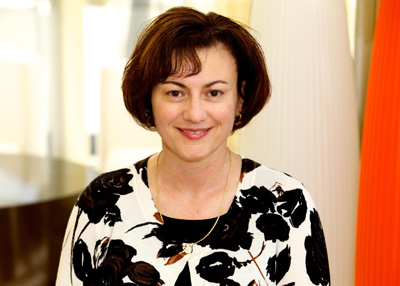Composed of a diverse array of faculty, staff and administrators, the Oakland University community is unique, creative, and dedicated. As part of a continuing effort to explore the various roles and lives of our Golden Grizzlies, the News @ OU website presents a new interview series. We invite you to share these stories and “Take 5” with OU.
“Take 5 with Tamara Jhashi”
Tamara Jhashi, Ph.D., is an associate professor of art history at Oakland University. Since arriving at Oakland in 1997, she has filled several roles, including four years of service as associate provost, and will serve as the chair of the Department of Art and Art History beginning in fall 2012. Tamara’s focus is early twentieth century art, and her area of specialization is Russian art, particularly from 1905-1932, which centers on the period of the Russian avant-garde. Over the years, Tamara has taught a variety of courses, from introductory art history to modern art seminars, Russian art and culture courses and senior thesis capstone projects.
1) Your area of specialization is Russian art of the twentieth century. What drew you to this particular place and type of art?
I earned my master’s in Medieval and Byzantine Art and have always been interested in iconography. After that, I actually went to law school for a while, which I didn’t like, and decided to return for my Ph.D. at Indiana University. I had the opportunity to study under a Russian art expert, and found it to be very exciting. My parents are from Russia, who came to the U.S. right after World War II. I grew up with my family speaking Russian at home, but I was the youngest and I always answered in English. While I was in Russia working on my doctorate, I met my husband, who was a student in Moscow at the time. We had similar backgrounds, and our parents were from the same regions. We’ve been married now for 21 years, and have a son who is now away in college.
2) Where did you go for the best vacation you ever had?
Actually the absolute best trip I have ever been on was what you could call a “working vacation.” It was the best two weeks of my life. I participated in a program for art professionals at the Hermitage Museum in St. Petersburg, which is the largest museum in the world. I was awarded a scholarship in Slavic studies from the university to attend. Our group of art professionals was treated like curators. We were able to go behinds the scenes and work with Hermitage curators to see some rare exhibits. It was such a privilege. We were treated so well and were taken on excursions to palaces with specialized tours, and able to see areas not open to tourists. It was one of the best things I’ve ever done. It was like magic every day.
3) What is your family like?
My husband is away often working overseas and my son is now attending college in Ohio, so I have more free time than I have had in the past. We have a place in Miami Beach that I try to visit once a month. It is so quiet there, so I can work, read, and think.. My family is a little geographically scattered right now, but we Skype and text often so we can stay close.
4) What are some of your techniques to engage students in the classroom?
In my introduction to art history courses, I always try to get my students to talk as much as possible. It is difficult to have an entire course period just devoted to lecture, and my students are generally able to generate a good discussion and stay engaged and interested. I like to ask questions that make students think about the images on the screen, and to really elicit a thoughtful response. I also try to use new technological components. It really opens up a world of new options and ideas. I have attended several workshops about using technology in the classroom and I have found that the opportunities are great. I’m teaching Art History 101 online this summer for the first time, and am learning a lot. I’ve already attended several workshops to learn about how to enliven discussion forums with students online and to really make the most of the course. I’m learning fast, but it will be challenging the first time around.
5) What changes have you seen at OU since you began?
Everything has changed! We have more programs, more students, more buildings. Having lived through this trying economic period as an academic administrator, I am proud to tell people how OU survived without cutting any programs or any faculty. It was even the reverse: we have added both new programs and new faculty members, which is extraordinary and unlike many other universities. Through an administrative lens, I saw the Herculean effort it took by the president, the provost and the senior leadership to protect and preserve our academic programs. We were even able to get a new medical school off the ground. Oakland’s growth has been really tremendous.

